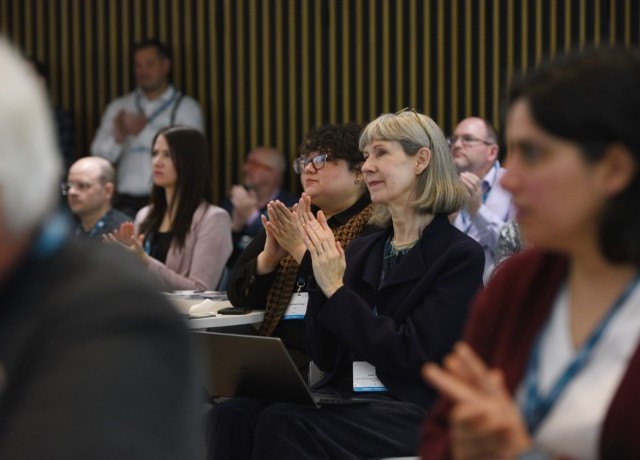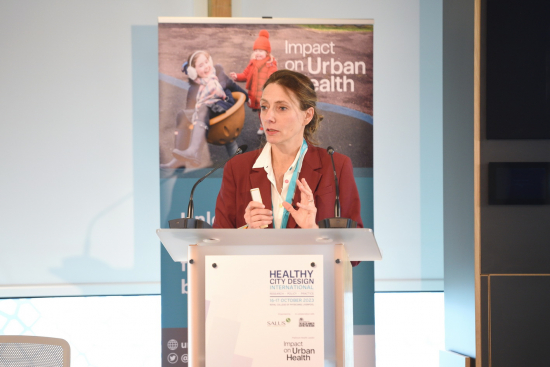
Keynote summary: Investing in urban renewal and health equity
As we enter an economic period when governments are likely to lack the firepower to tackle the scale of problems that lie in front of them, the potential of impact investing should be considered as an important tool to help create a healthier society.
Delivering a keynote talk at the Healthy City Design International Congress, Kieron Boyle, chief executive of the Impact Investing Institute, explained the principles of impact investing, a megatrend that is broadly about investing with intentionality for people and the planet, and which is rapidly growing and set to become a £26tn market by 2030.
It’s driven by two factors, said Boyle – firstly, a recognition of wider externalities on long-term investment performance. “If you’re a big enough or long-term investor, increasingly, it’s starting to feel that those externalities aren’t so external anymore,” he reasoned. “They’re beginning to impact on the investment portfolio itself. That’s clearest through climate but you can make the same arguments in terms of health.”
Secondly, large pension funds effectively own a slice of society, and how society performs has an impact on investment performance, explained Boyle, while there is also a recognition that the things you do impact on the world, and what the world does impacts on you. At the same time, there has been a growth in attractive commercial opportunities in solutions-focused businesses – whether that be, for example, in clean energy, in housing and health, in agriculture and food, for in forestry and nature.
“Impact investing sits within a spectrum of capital,” Boyle observed. “On one side of the spectrum you have traditional capital – capital that hasn’t been very thoughtful about anything other than short-term financial returns. On the other side of the spectrum, you have philanthropy, which is capital that doesn’t need to replenish itself. And there are all sorts of different capital that sit between the two, each with different mandates.”
He also noted that the ABC framework is increasingly becoming an important means by which people approach investment. Under this model, A = avoid harm and mitigate risks; B = benefit stakeholders; and C = contribute to solutions. “ESG often focuses on A – how do you avoid harms or exclude things that may be harmful to the world,” said Boyle. “A lot of impact investing is focused on the B and C.”
The investment case for health
In setting out the investment case for health, Boyle argued that good health is a necessary requirement for economic growth, and “like any asset, it needs nurturing and stewardship, which at a societal level has often been lacking”. Evidence points to a compelling case for investors to consider health – 15m people die prematurely each year from preventable poor health; 63 per cent of years lost to poor health are in the working-age population; and US$12 trillion can be added to global GDP by 2040 through better health.
“Commercial activities are responsible for many of the greatest harms to our health,” said Boyle. “If you were to take tobacco, poor food, alcohol, and improve health outcomes around those, we could reduce anything up to 75 per cent of heart disease, diabetes or stroke, or reduce cancer by up to 40 per cent.”
Businesses can make a great impact in these areas, he said, and societal expectations also pose an opportunity for investors.
 Kieron Boyle, chief executive of the Impact Investing Institute
Kieron Boyle, chief executive of the Impact Investing Institute
Many impact investors are also developing a place-based lens, focusing on the strengths and needs of a place
Opportunities
The potential for impact investing to make a difference in health is significant, and Boyle pointed to a number of opportunities for change. There has always been a lot of investment in healthcare, reflected Boyle, but some investors are now taking a broader view of health, from access to healthcare to the social determinants, for example, affordable housing, environmental health, food and nutrition, financial inclusion, etc.
“Many impact investors are also developing a place-based lens,” said Boyle, “focusing on the strengths and needs of a place. How do you direct capital to underinvested areas, working in places to identify the assets of the areas and the challenges they face, and thinking about investing in a holistic way?”
As an example, he cited the South Yorkshire Pension Fund, a local government pension scheme that has invested over £100 million in South Yorkshire at the intersection of SME finance, affordable housing, and renewable energy. That’s investing in things like converting foundries into environmentally friendly homes, focused on young graduates to keep people in the local area and all that that means for the brain drain and local economic growth.”
Often, impact investing incorporates a ‘just transition’ lens, where environmental, social and community outcomes are aligned. An example in this area is BlueOrchard, an investment partner that focuses on fighting inequality and the effects of climate change. The company is investing in micro insurance, working with a technology and impact measurement firm called 60 Decibels to find ways of surveying end consumers, often some of the poorest people in the world, on whether the product is working and having the desired impact.
And an increasing number of investors are also using their ownership of companies to affect change. There are lots of investors, for example, engaging in the net-zero policies and carbon emission practices of large businesses, noted Boyle, often categorising oil and gas as “stranded assets” that don’t have a place in an investment portfolio.
“Increasingly, people are saying unhealthy food or sugary food is a stranded asset too,” Boyle added. “In fact, there are more sugar taxes around the world than there are carbon taxes, and investors are increasingly paying attention to that.”
Challenges
While there are opportunities that exist, there are several challenges to impact investing on health, too, with Boyle stressing that there are always risks in aligning public and private interests. But there are also other issues around investment models, engagement, and the prevailing discourse around health.
“We need more models of investments in urban health equity,” said Boyle, “particularly at scale, and we may need more blended capital products. Governments have also been slow to take advantage of this capital – growing engagement around clean energy but not so much around health and the wider determinants of health.”
He added: “This is as much about mindset as it is finance. The discourse still sees health as an individual issue, not a collective issue; it still focuses more on healthcare above a wider definition of health and social determinants; there is a tendency to polish the problem rather than tackle the root causes [of ill health]; and [the discourse] still sees health as a cost and liability rather than an asset that can be invested in for future generations.”
Ultimately, however, “you never change things by fighting the existing reality,” said Boyle, quoting the late US architect and systems theorist Richard Buckminster Fuller. “To change something, build a new model that makes the existing model obsolete.”
Concluded Boyle: “Perhaps by accessing new capital and new forms of capital, that can be one of the tools that can help us do that.”
Event news
Actions to improve urban renewal and health equity
2nd September 2024
A vision for Liverpool: Putting people’s health first
2nd September 2024
Investing in urban renewal and health equity
21st March 2024
Health equity: Marmot Cities
20th March 2024
















